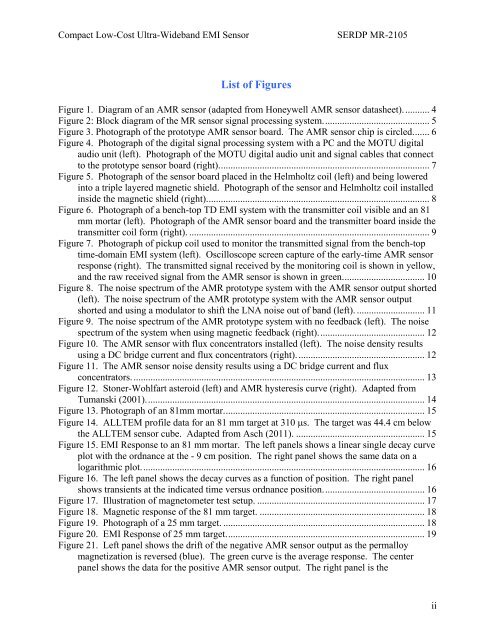Final Report - Strategic Environmental Research and Development ...
Final Report - Strategic Environmental Research and Development ...
Final Report - Strategic Environmental Research and Development ...
Create successful ePaper yourself
Turn your PDF publications into a flip-book with our unique Google optimized e-Paper software.
Compact Low-Cost Ultra-Wideb<strong>and</strong> EMI SensorSERDP MR-2105List of FiguresFigure 1. Diagram of an AMR sensor (adapted from Honeywell AMR sensor datasheet). .......... 4Figure 2: Block diagram of the MR sensor signal processing system. ........................................... 5Figure 3. Photograph of the prototype AMR sensor board. The AMR sensor chip is circled. ...... 6Figure 4. Photograph of the digital signal processing system with a PC <strong>and</strong> the MOTU digitalaudio unit (left). Photograph of the MOTU digital audio unit <strong>and</strong> signal cables that connectto the prototype sensor board (right). ...................................................................................... 7Figure 5. Photograph of the sensor board placed in the Helmholtz coil (left) <strong>and</strong> being loweredinto a triple layered magnetic shield. Photograph of the sensor <strong>and</strong> Helmholtz coil installedinside the magnetic shield (right). ........................................................................................... 8Figure 6. Photograph of a bench-top TD EMI system with the transmitter coil visible <strong>and</strong> an 81mm mortar (left). Photograph of the AMR sensor board <strong>and</strong> the transmitter board inside thetransmitter coil form (right). ................................................................................................... 9Figure 7. Photograph of pickup coil used to monitor the transmitted signal from the bench-toptime-domain EMI system (left). Oscilloscope screen capture of the early-time AMR sensorresponse (right). The transmitted signal received by the monitoring coil is shown in yellow,<strong>and</strong> the raw received signal from the AMR sensor is shown in green. ................................. 10Figure 8. The noise spectrum of the AMR prototype system with the AMR sensor output shorted(left). The noise spectrum of the AMR prototype system with the AMR sensor outputshorted <strong>and</strong> using a modulator to shift the LNA noise out of b<strong>and</strong> (left). ............................ 11Figure 9. The noise spectrum of the AMR prototype system with no feedback (left). The noisespectrum of the system when using magnetic feedback (right). ........................................... 12Figure 10. The AMR sensor with flux concentrators installed (left). The noise density resultsusing a DC bridge current <strong>and</strong> flux concentrators (right). .................................................... 12Figure 11. The AMR sensor noise density results using a DC bridge current <strong>and</strong> fluxconcentrators. ........................................................................................................................ 13Figure 12. Stoner-Wohlfart asteroid (left) <strong>and</strong> AMR hysteresis curve (right). Adapted fromTumanski (2001). .................................................................................................................. 14Figure 13. Photograph of an 81mm mortar. .................................................................................. 15Figure 14. ALLTEM profile data for an 81 mm target at 310 s. The target was 44.4 cm belowthe ALLTEM sensor cube. Adapted from Asch (2011). ..................................................... 15Figure 15. EMI Response to an 81 mm mortar. The left panels shows a linear single decay curveplot with the ordnance at the - 9 cm position. The right panel shows the same data on alogarithmic plot. .................................................................................................................... 16Figure 16. The left panel shows the decay curves as a function of position. The right panelshows transients at the indicated time versus ordnance position. ......................................... 16Figure 17. Illustration of magnetometer test setup. ..................................................................... 17Figure 18. Magnetic response of the 81 mm target. .................................................................... 18Figure 19. Photograph of a 25 mm target. ................................................................................... 18Figure 20. EMI Response of 25 mm target. ................................................................................. 19Figure 21. Left panel shows the drift of the negative AMR sensor output as the permalloymagnetization is reversed (blue). The green curve is the average response. The centerpanel shows the data for the positive AMR sensor output. The right panel is theii
















